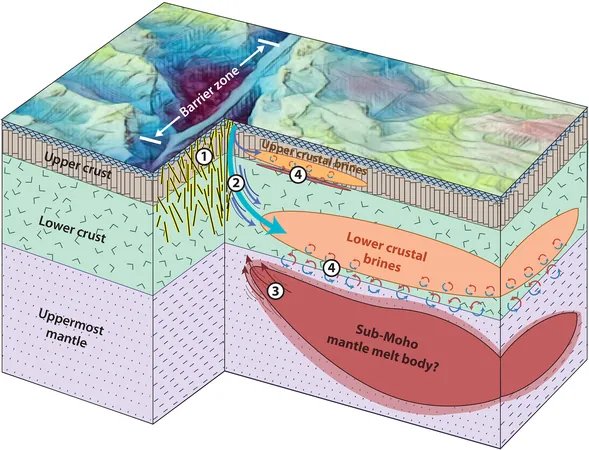
Game-Changer in Earth Science: Uncovering Surprising Brine Reservoirs at Oceanic Transform Faults!
2025-04-14
Author: Jacob
Revolutionary Discoveries Beneath the Deep Blue
A groundbreaking study from the Woods Hole Oceanographic Institution (WHOI) has unveiled a startling new look at an oceanic transform fault. The research, published in Science Advances, presents striking electromagnetic (EM) data gathered from the Gofar fault in the eastern Pacific Ocean, revealing unexpected brine deposits lurking beneath the seabed.
The Mysteries of the Gofar Fault Unraveled
Much like California’s infamous San Andreas Fault, the Gofar fault sees two tectonic plates sliding past each other. However, this fault holds an intriguing twist: it experiences large earthquakes in a remarkably predictable pattern every five to six years. This consistency positions Gofar as a prime research site for understanding earthquake dynamics.
Shocking Insights from Electromagnetic Data
EM measurements, which gauge how well materials conduct electricity, have provided invaluable insights. The salt found in seawater allows for high conductivity, helping scientists identify where fluids may be hidden beneath the seafloor—a key factor influencing fault behavior and earthquake occurrences. Researchers anticipated that the fault's conductivity would showcase a minor variation; however, they were astounded to discover strikingly conductive blobs existing beneath only one side of the fault.
A Complex Puzzle to Solve
Christine Chesley, a postdoctoral researcher at WHOI and lead author, described the surprise at detecting such marked differences: "The conductivity structure defied all of our expectations based on what we thought we knew about oceanic transform faults." This finding challenges the historical perception of these faults as simple and predictable.
A New Perspective on Transform Faults
Traditionally, oceanic transform faults have been the least understood of the three major plate boundaries, which also include divergent boundaries (like those in East Africa) and convergent boundaries (such as the Himalayas). Recent discoveries necessitate a fresh approach to understanding these geological features. Rob Evans, a senior scientist at WHOI, expressed the transformative potential of their research: "These EM measurements allow us to view the seafloor through a different lens, reshaping our understanding of Earth's processes."
Unveiling the Source of the Conductive Anomalies
Investigating the origins of these peculiar conductive blobs led the researchers to consider the presence of an abundant salt source beneath the fault, possibly indicating accumulations of brine. Chesley noted that such high conductivity values are usually associated with magma. This suggests a compelling hypothesis: magma may be present on the side of the fault where the conductive brine resides, potentially revolutionizing our understanding of transform faults and their volcanic activity.
A Transformational Shift in Geology
This discovery could significantly alter scientific viewpoints on the geological processes at play along transform faults, inviting further exploration and research into these fascinating underwater landscapes. The implications for earthquake prediction and geological modeling could be profound, hinting at a hidden world beneath the ocean that remains largely uncharted.









 Brasil (PT)
Brasil (PT)
 Canada (EN)
Canada (EN)
 Chile (ES)
Chile (ES)
 Česko (CS)
Česko (CS)
 대한민국 (KO)
대한민국 (KO)
 España (ES)
España (ES)
 France (FR)
France (FR)
 Hong Kong (EN)
Hong Kong (EN)
 Italia (IT)
Italia (IT)
 日本 (JA)
日本 (JA)
 Magyarország (HU)
Magyarország (HU)
 Norge (NO)
Norge (NO)
 Polska (PL)
Polska (PL)
 Schweiz (DE)
Schweiz (DE)
 Singapore (EN)
Singapore (EN)
 Sverige (SV)
Sverige (SV)
 Suomi (FI)
Suomi (FI)
 Türkiye (TR)
Türkiye (TR)
 الإمارات العربية المتحدة (AR)
الإمارات العربية المتحدة (AR)